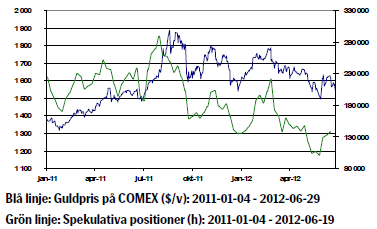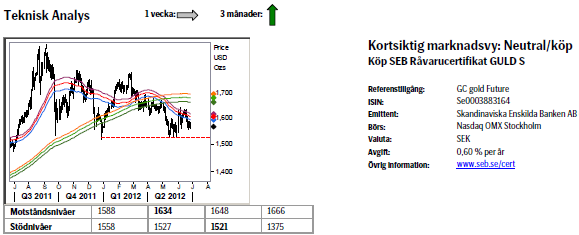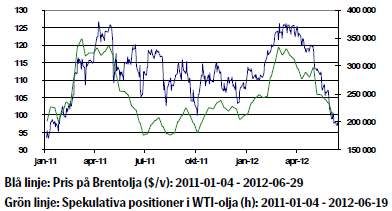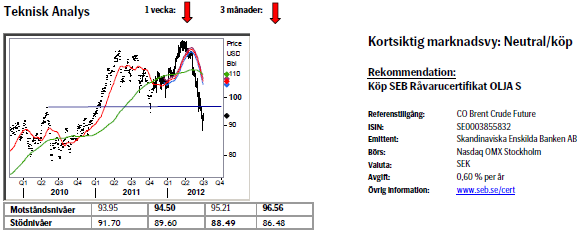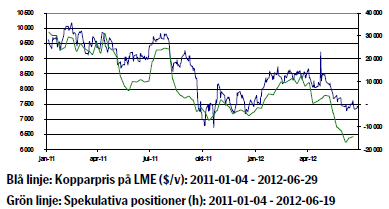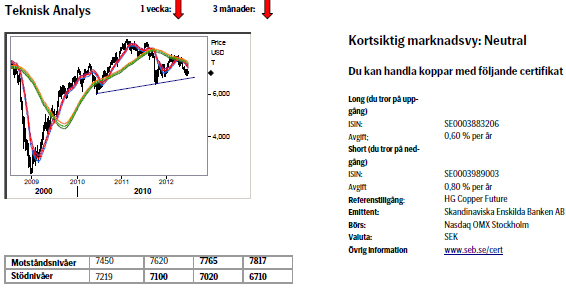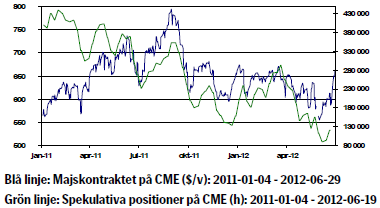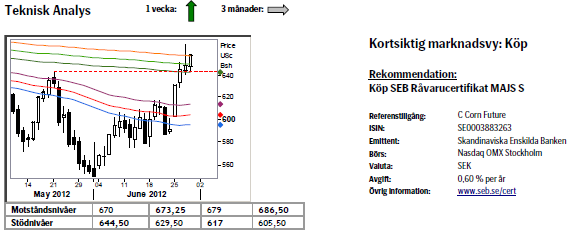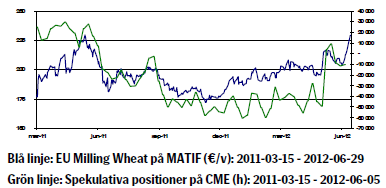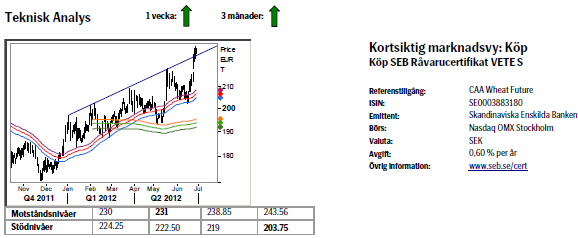Analys
SEB – Råvarukommentarer vecka 26 2012
Sammanfattning: Denna vecka
- Brett råvaruindex: +2,74%
UBS Bloomberg CMCI TR Index - Energi: +1,05%
UBS Bloomberg CMCI Energy TR Index - Ädelmetaller: +0,18%
UBS Bloomberg CMCI Precious Metals TR Index - Industrimetaller: +1,44%
UBS Bloomberg CMCI Industrial Metals TR Index - Jordbruk: +6,44%
UBS Bloomberg CMCI Agriculture TR Index
Kortsiktig marknadsvy:
- Guld: Neutral/köp
- Olja: Neutral/köp
- Koppar: Neutral
- Majs: Köp
- Vete: Köp
Guld
Fokus i veckan har riktats mot gårdagens och dagens EU-toppmöte. Tongångarna mellan ledarna har varit skarpa och den rådande oenigheten är stor, framförallt vad gäller möjligheten till en framtida fiskal integration, något som skulle inskränka ländernas nationella självbestämmande. Möjligheterna att EU-ledarna ska komma fram till några tydliga beslut måste betraktas som små. Idag på morgon är det övervägande positiv stämning som överväger det negativa sentiment som rådde igår. Natten till idag enades ledarna att några nödvändiga punkter som börjar likna en krisplan.
Oron för Spanien fortsätter och i veckan kom dessutom formella ansökningar om stöd från både Cypern och Spanien.
I Grekland är en ny regering på plats och det finns förmodligen ett visst utrymme för att man ska komma överens med sina långivare om smärre lättnader i villkoren för stödlånen.
Guldet har backat 0,10 procent under veckan. Vi anser inte att guldrally är troligt men att vi kommer se högre priser på kort sikt.
Teknisk analys: Tillbaka under 55d bandet.
Något förvånande, i.a.f. för undertecknad, föll den gula metallen tillbaka under 55dagars bandet, något som gör att vi måste vara lite försiktigare. Fortfarande gäller att så länge vi inte bryter under decembers botten, 1521, så kvarstår den generellt positiva vyn. Förnyad styrka utlöses vid uppgång över 1634.
Olja
Priset på Brentolja steg 2,3 procent under veckan och handlade vid fler tillfällen under 90 dollar nivån. En av orsakerna till det fallande oljepriset är det utbudsöverskott som vi ser för tillfället.
Den pågående strejken bland norska oljearbetare minskar oljeproduktionen med cirka 200 000 fat per dag vilket ger stöd åt priset.
EU-ländernas embargo mot Iran träder i kraft nästa vecka. Försäkringsbolag i Europa är förbjudna att försäkra oljefrakt från Iran. Effekterna av sanktionerna mot Iran börjar bli kännbara för landets invånare och dess regim. En mycket försvårande omständighet för landet är kraftigt ökade spannmålspriser på världsmarknaden vilka bidrar till att hålla inflationen hög.
American Petroleum Institute publicerade i tisdags den inofficiella statistiken över amerikanska oljelager vilken visade att lagren av råolja steg med 0,5 miljoner fat förra veckan. Statistiken från USA:s energidepartement, DOE, inkom i onsdags och visade att lagren av råolja sjönk med ringa 0,1 miljoner fat under förra veckan.
Positiva nyheter från EU-toppmötet och en fortsatt försvagning av dollarn kan snabbt ge ett Brentpris över hundra dollar. På kort sikt ser det fortsatt osäkert ut.
Teknisk analys: Ramlade ned i falluckan.
En ny stark säljsignal utlöstes i och med förra veckans stängning. Då vi nu fallit igenom huvudstödet sätter vi ett nytt medelsiktigt mål runt $78. Uppgångar förväntas bli temporära och inte orka mycket mer än 96.50 området samt om de inträffar utnyttjas till att sälja.
Koppar
Kopparpriset steg 3,2 procent under veckan.
I onsdags publicerades kontrakterade hus affärer i USA vilka överraskade positivt och kopparpriset steg på siffrorna. Antalet nya kontrakt om köp av befintliga bostäder i USA steg med 5,9 procent i maj jämfört med föregående månad. Det framgår av National Association of Realtors, NAR, index över kontrakterade husaffärer.
På grund av risken för inflation i Kina om matpriser fortsätter att stiga kan kinesiska myndigheter som följd avvakta med de stimulanser man tidigare annonserat vilket skulle påverka kopparpriset negativt.
Med en europeisk skuldkris som fortsätter skapa stor osäkerhet och allmänt sett svag makrostatistik med en långsam återhämtning i USA och en inbromsning i Kina är risken stor att kopparpriset ligger kvar på nuvarande nivåer på kort sikt.
Teknisk analys: Nacklinjen nästa.
Den mindre uppgång som vi såg som ytterst korrektiv har nu avslutats och marknaden följaktligen vänt nedåt. Nästa viktiga steg kommer att bli ett test av nacklinjen (av den stora huvud-skuldra formation som nu befinner sig i sitt slutskede (nickel o alu har redan brutit ned från liknande toppformationer) och ett brott (troligt) bör få långtgående implikationer för kopparpriset.
Majs
Amerikansk majs har handlats upp kraftigt p.g.a. av den allvarliga torka som råder i USA och majsen fortsätter att handla på höga nivåer. Bristen på fukt kan komma påverka kvalitén negativt. Majspriset steg 15 procent under veckan och det är en helt väderrelaterad prisökning.
Spreaden mellan juliterminskontraktet och decemberterminskontraktet har minskat till 20-månaders lägsta eftersom priset på närliggande terminskontrakt stigit kraftigt p.g.a. ökad oro för den kommande skörden.
I Europa är däremot vädret betydligt mera gynnsamt.
Enligt USDA crop report för den amerikanska majsen är andelen good/excellent 56 procent, jämfört med 63 procent föregående vecka. Samma period föregående år låg nivåerna på 70 procent.
Andelen poor/very poor låg på 14 procent, förra veckan 9 procent jämfört med samma period förra året då nivån låg på 9 procent.
Ser man till hedgefonder och spekulanter är de enligt US Commodity Futures Trading Commission fortsatt försiktigt positionerade för högre priser med 70 715 utstående terminer och optioner i juni jämfört med ett två års genomsnitt på 257 000 kontrakt per månad.
Teknisk analys: Fortsatt rally.
Rallyt har fortsatt sedan förra veckan och därigenom ökat på den positiva bilden pga 1) att vi nu passerat 55dagars bandet samt 2) att vi passerat föregående rekyltopp. Sammantaget finner vi att sannolikheten för ytterligare uppgång ser bra ut varför vi rekommenderar att köpa ett återtest av brottet av majtoppen.
Vete
Jordbrukssektorn har fortsatt högre under veckan. Förhållandena i de viktiga amerikanska odlingsområdena är fortsatt mycket torra och heta.
De senaste väderprognoserna håller fast vid hett och torrt väder och risken ökar för ytterligare skada/sämre skördar.
Enligt USDA crop report för vintervetet är andelen good/excellent 54 procent, samma siffra som föregående vecka. Samma period föregående år låg nivåerna på 25 procent.
För vårvetet är andelen good/excellent 77 procent jämfört med föregående vecka då det var 76 procent. Samma period föregående år var andelen 69 procent. I Europa gynnar regnet i de norra regionerna det planterade vetet medan det torra och varma vädret fortsätter i de södra delarna där skörden alltså kan fortgå utan problem.
I USA finns det på grund av torkan risker för skador men några större skador har ännu inte skett i praktiken. Situationen kan alltså förbättras snabbt om man får lite mer regn.
Teknisk analys: Upp i överljudsfart.
I en enastående hastighet har marknaden stigit sedan det senaste besöket i 55dagars bandet, vilket ligger helt i plan med vår vy, denna pekade som sagt var inte bara på ett återtest av 218.75 utan också att 2011 års topp, 231, ska passeras. Ligg lång men passopp om vi återvänder ned under den tidigare topplinjen.
[box]SEB Veckobrev Veckans råvarukommentar är producerat av SEB Merchant Banking och publiceras i samarbete och med tillstånd på Råvarumarknaden.se[/box]
Disclaimer
The information in this document has been compiled by SEB Merchant Banking, a division within Skandinaviska Enskilda Banken AB (publ) (“SEB”).
Opinions contained in this report represent the bank’s present opinion only and are subject to change without notice. All information contained in this report has been compiled in good faith from sources believed to be reliable. However, no representation or warranty, expressed or implied, is made with respect to the completeness or accuracy of its contents and the information is not to be relied upon as authoritative. Anyone considering taking actions based upon the content of this document is urged to base his or her investment decisions upon such investigations as he or she deems necessary. This document is being provided as information only, and no specific actions are being solicited as a result of it; to the extent permitted by law, no liability whatsoever is accepted for any direct or consequential loss arising from use of this document or its contents.
About SEB
SEB is a public company incorporated in Stockholm, Sweden, with limited liability. It is a participant at major Nordic and other European Regulated Markets and Multilateral Trading Facilities (as well as some non-European equivalent markets) for trading in financial instruments, such as markets operated by NASDAQ OMX, NYSE Euronext, London Stock Exchange, Deutsche Börse, Swiss Exchanges, Turquoise and Chi-X. SEB is authorized and regulated by Finansinspektionen in Sweden; it is authorized and subject to limited regulation by the Financial Services Authority for the conduct of designated investment business in the UK, and is subject to the provisions of relevant regulators in all other jurisdictions where SEB conducts operations. SEB Merchant Banking. All rights reserved.
Analys
Tightening fundamentals – bullish inventories from DOE

The latest weekly report from the US DOE showed a substantial drawdown across key petroleum categories, adding more upside potential to the fundamental picture.

Commercial crude inventories (excl. SPR) fell by 5.8 million barrels, bringing total inventories down to 415.1 million barrels. Now sitting 11% below the five-year seasonal norm and placed in the lowest 2015-2022 range (see picture below).
Product inventories also tightened further last week. Gasoline inventories declined by 2.1 million barrels, with reductions seen in both finished gasoline and blending components. Current gasoline levels are about 3% below the five-year average for this time of year.
Among products, the most notable move came in diesel, where inventories dropped by almost 4.1 million barrels, deepening the deficit to around 20% below seasonal norms – continuing to underscore the persistent supply tightness in diesel markets.
The only area of inventory growth was in propane/propylene, which posted a significant 5.1-million-barrel build and now stands 9% above the five-year average.
Total commercial petroleum inventories (crude plus refined products) declined by 4.2 million barrels on the week, reinforcing the overall tightening of US crude and products.


Analys
Bombs to ”ceasefire” in hours – Brent below $70

A classic case of “buy the rumor, sell the news” played out in oil markets, as Brent crude has dropped sharply – down nearly USD 10 per barrel since yesterday evening – following Iran’s retaliatory strike on a U.S. air base in Qatar. The immediate reaction was: “That was it?” The strike followed a carefully calibrated, non-escalatory playbook, avoiding direct threats to energy infrastructure or disruption of shipping through the Strait of Hormuz – thus calming worst-case fears.

After Monday morning’s sharp spike to USD 81.4 per barrel, triggered by the U.S. bombing of Iranian nuclear facilities, oil prices drifted sideways in anticipation of a potential Iranian response. That response came with advance warning and caused limited physical damage. Early this morning, both the U.S. President and Iranian state media announced a ceasefire, effectively placing a lid on the immediate conflict risk – at least for now.
As a result, Brent crude has now fallen by a total of USD 12 from Monday’s peak, currently trading around USD 69 per barrel.
Looking beyond geopolitics, the market will now shift its focus to the upcoming OPEC+ meeting in early July. Saudi Arabia’s decision to increase output earlier this year – despite falling prices – has drawn renewed attention considering recent developments. Some suggest this was a response to U.S. pressure to offset potential Iranian supply losses.
However, consensus is that the move was driven more by internal OPEC+ dynamics. After years of curbing production to support prices, Riyadh had grown frustrated with quota-busting by several members (notably Kazakhstan). With Saudi Arabia cutting up to 2 million barrels per day – roughly 2% of global supply – returns were diminishing, and the risk of losing market share was rising. The production increase is widely seen as an effort to reassert leadership and restore discipline within the group.
That said, the FT recently stated that, the Saudis remain wary of past missteps. In 2018, Riyadh ramped up output at Trump’s request ahead of Iran sanctions, only to see prices collapse when the U.S. granted broad waivers – triggering oversupply. Officials have reportedly made it clear they don’t intend to repeat that mistake.
The recent visit by President Trump to Saudi Arabia, which included agreements on AI, defense, and nuclear cooperation, suggests a broader strategic alignment. This has fueled speculation about a quiet “pump-for-politics” deal behind recent production moves.
Looking ahead, oil prices have now retraced the entire rally sparked by the June 13 Israel–Iran escalation. This retreat provides more political and policy space for both the U.S. and Saudi Arabia. Specifically, it makes it easier for Riyadh to scale back its three recent production hikes of 411,000 barrels each, potentially returning to more moderate increases of 137,000 barrels for August and September.
In short: with no major loss of Iranian supply to the market, OPEC+ – led by Saudi Arabia – no longer needs to compensate for a disruption that hasn’t materialized, especially not to please the U.S. at the cost of its own market strategy. As the Saudis themselves have signaled, they are unlikely to repeat previous mistakes.
Conclusion: With Brent now in the high USD 60s, buying oil looks fundamentally justified. The geopolitical premium has deflated, but tensions between Israel and Iran remain unresolved – and the risk of missteps and renewed escalation still lingers. In fact, even this morning, reports have emerged of renewed missile fire despite the declared “truce.” The path forward may be calmer – but it is far from stable.
Analys
A muted price reaction. Market looks relaxed, but it is still on edge waiting for what Iran will do

Brent crossed the 80-line this morning but quickly fell back assigning limited probability for Iran choosing to close the Strait of Hormuz. Brent traded in a range of USD 70.56 – 79.04/b last week as the market fluctuated between ”Iran wants a deal” and ”US is about to attack Iran”. At the end of the week though, Donald Trump managed to convince markets (and probably also Iran) that he would make a decision within two weeks. I.e. no imminent attack. Previously when when he has talked about ”making a decision within two weeks” he has often ended up doing nothing in the end. The oil market relaxed as a result and the week ended at USD 77.01/b which is just USD 6/b above the year to date average of USD 71/b.

Brent jumped to USD 81.4/b this morning, the highest since mid-January, but then quickly fell back to a current price of USD 78.2/b which is only up 1.5% versus the close on Friday. As such the market is pricing a fairly low probability that Iran will actually close the Strait of Hormuz. Probably because it will hurt Iranian oil exports as well as the global oil market.
It was however all smoke and mirrors. Deception. The US attacked Iran on Saturday. The attack involved 125 warplanes, submarines and surface warships and 14 bunker buster bombs were dropped on Iranian nuclear sites including Fordow, Natanz and Isfahan. In response the Iranian Parliament voted in support of closing the Strait of Hormuz where some 17 mb of crude and products is transported to the global market every day plus significant volumes of LNG. This is however merely an advise to the Supreme leader Ayatollah Ali Khamenei and the Supreme National Security Council which sits with the final and actual decision.
No supply of oil is lost yet. It is about the risk of Iran closing the Strait of Hormuz or not. So far not a single drop of oil supply has been lost to the global market. The price at the moment is all about the assessed risk of loss of supply. Will Iran choose to choke of the Strait of Hormuz or not? That is the big question. It would be painful for US consumers, for Donald Trump’s voter base, for the global economy but also for Iran and its population which relies on oil exports and income from selling oil out of that Strait as well. As such it is not a no-brainer choice for Iran to close the Strait for oil exports. And looking at the il price this morning it is clear that the oil market doesn’t assign a very high probability of it happening. It is however probably well within the capability of Iran to close the Strait off with rockets, mines, air-drones and possibly sea-drones. Just look at how Ukraine has been able to control and damage the Russian Black Sea fleet.
What to do about the highly enriched uranium which has gone missing? While the US and Israel can celebrate their destruction of Iranian nuclear facilities they are also scratching their heads over what to do with the lost Iranian nuclear material. Iran had 408 kg of highly enriched uranium (IAEA). Almost weapons grade. Enough for some 10 nuclear warheads. It seems to have been transported out of Fordow before the attack this weekend.
The market is still on edge. USD 80-something/b seems sensible while we wait. The oil market reaction to this weekend’s events is very muted so far. The market is still on edge awaiting what Iran will do. Because Iran will do something. But what and when? An oil price of 80-something seems like a sensible level until something do happen.
-

 Nyheter4 veckor sedan
Nyheter4 veckor sedanStor uppsida i Lappland Guldprospekterings aktie enligt analys
-

 Nyheter4 veckor sedan
Nyheter4 veckor sedanSilverpriset släpar efter guldets utveckling, har mer uppsida
-

 Nyheter3 veckor sedan
Nyheter3 veckor sedanUppgången i oljepriset planade ut under helgen
-

 Nyheter3 veckor sedan
Nyheter3 veckor sedanLåga elpriser i sommar – men mellersta Sverige får en ökning
-

 Nyheter2 veckor sedan
Nyheter2 veckor sedanMahvie Minerals växlar spår – satsar fullt ut på guld
-

 Analys3 veckor sedan
Analys3 veckor sedanVery relaxed at USD 75/b. Risk barometer will likely fluctuate to higher levels with Brent into the 80ies or higher coming 2-3 weeks
-

 Nyheter1 vecka sedan
Nyheter1 vecka sedanOljan, guldet och marknadens oroande tystnad
-

 Nyheter1 vecka sedan
Nyheter1 vecka sedanJonas Lindvall är tillbaka med ett nytt oljebolag, Perthro, som ska börsnoteras



